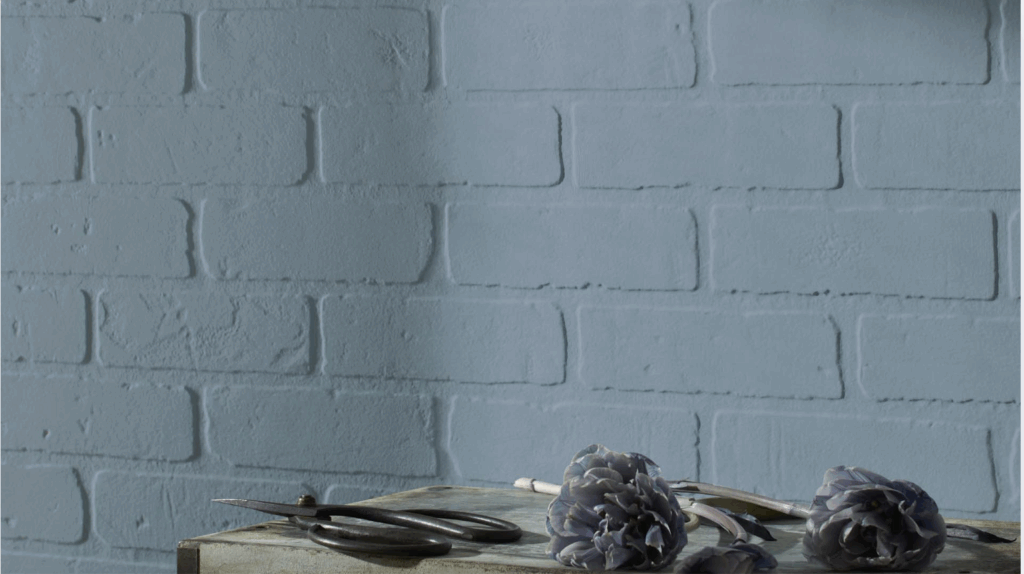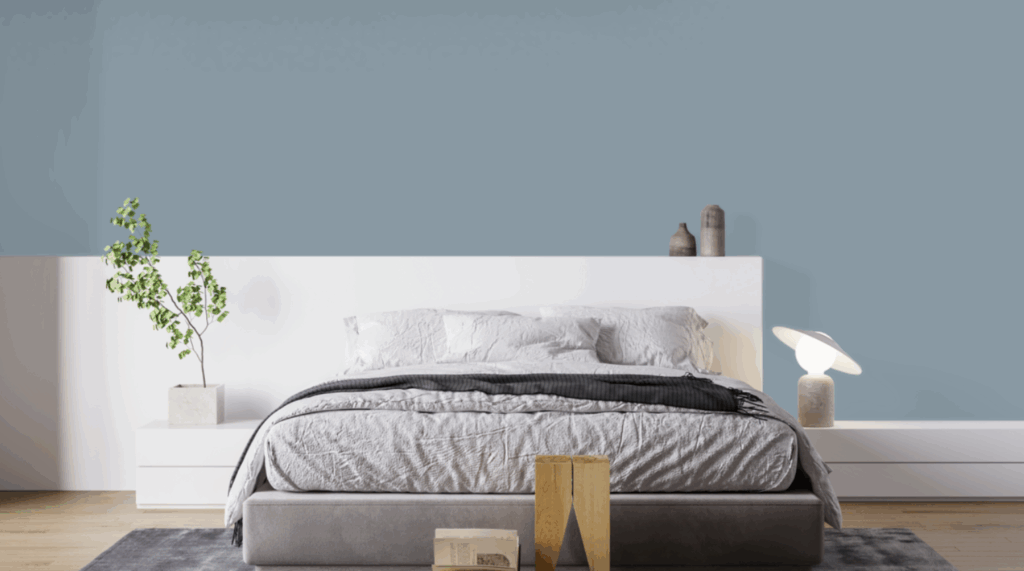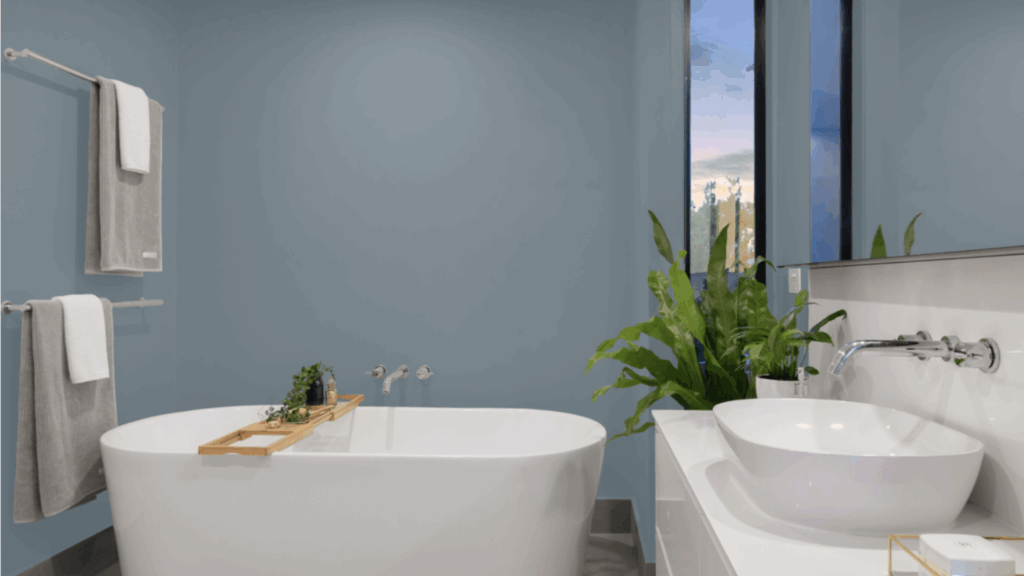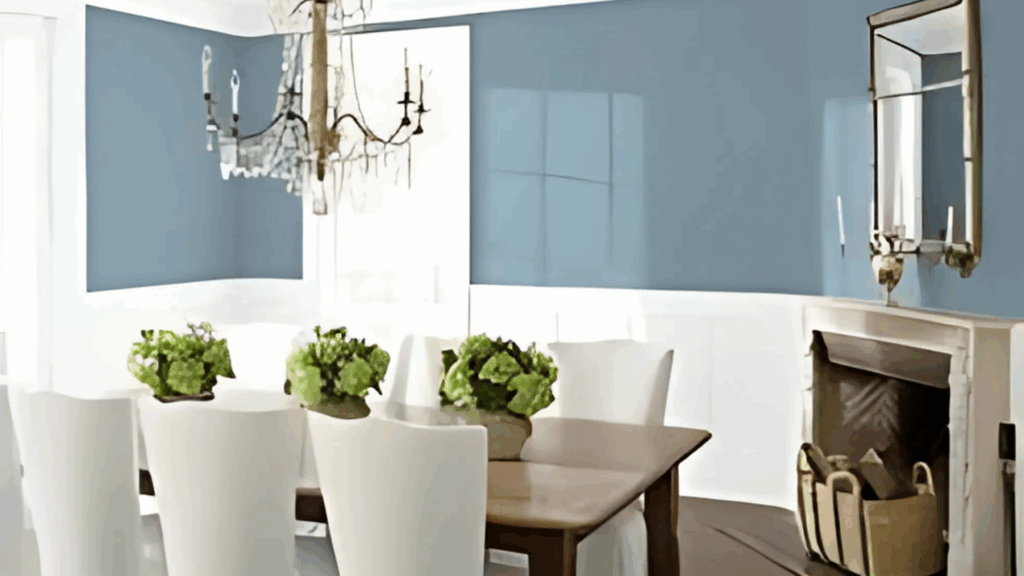-
I’ve been living with Benjamin Moore’s Polaris Blue on my walls for about a year now, and I’m excited to share what I’ve learned about this cool, soothing color. This rich blue has changed my home in unexpected ways.
In this blog, you’ll learn:
- What Polaris Blue actually looks like in real homes
- Which rooms work best with this color
- Colors that pair perfectly with it
- How to test it properly before buying
I’ve used this paint in several rooms with different light exposures and noticed how it shifts throughout the day. I’ve made the mistakes, so you don’t have to.
Let’s see if this cool, calming blue is right for your home.
What Kind of Color Is Polaris Blue?

Polaris Blue (Benjamin Moore 1649) is a cool, medium-depth blue with subtle gray undertones. It creates a calm background and adds a cool, fresh feeling to any room.
I see it as the color of a clear winter sky or deep ocean water—cool, clean, and full of depth.
I’ve watched it change throughout the day. In morning light, it shows more of its blue character.
By afternoon, the gray aspects become more noticeable, and in evening light, it takes on a deeper, more intimate quality.
The color has an LRV (Light Reflectance Value) of 29.27, placing it in the medium range. This means it absorbs more light than it reflects while still being clear enough to add character to a room.
The balanced nature of Polaris Blue makes it perfect for creating spaces that feel both cool and cozy.
What makes Polaris Blue stand out is its ability to create a sense of calm and depth. In most spaces, it adds a feeling of quietness and coolness with a depth that works in many settings and home styles.
What Rooms Work Best with Polaris Blue?
I’ve found that Polaris Blue works wonderfully in spaces where you want a cool, deep look that will last for years.
Based on my experience, here are the spaces where Polaris Blue performs best:
Living Rooms

This color makes living spaces feel rich and welcoming. It creates a cool background that allows furniture and art to stand out nicely.
In my living room, Polaris Blue walls make the space feel complete while highlighting my cream sofa and wood accent pieces.
The color works especially well in spaces that need to feel cozy without being too dark. When paired with warm lighting, it creates a room that feels both cool and comforting.
Bedrooms

Polaris Blue can transform bedrooms into calm, restful spaces. I used it in my guest bedroom, where it created a peaceful atmosphere.
The cool blue tones help create a relaxing feeling while still being more interesting than plain gray.
What surprised me is how well it works with different fabric tones.
My white bedding looks sharp against the Polaris Blue walls, while the lighter beige throw pillows bring warmth that balances the coolness of the walls. The room feels like a high-end hotel, special yet comfortable.
Home Offices

Polaris Blue helps create focus and calm in work areas. The balanced blue feels cool yet comfortable during long work hours.
I painted my home office accent wall in this shade and find it creates the perfect background for video calls while keeping me relaxed and focused.
Polaris Blue is particularly useful in offices that need to feel both professional and comfortable. The color seems to add depth while helping with concentration.
I’ve noticed I feel more productive in my Polaris Blue office compared to my previous, plain white workspace.
Bathrooms

This cool blue can add a touch of spa-like serenity to these functional spaces.
I painted my small powder room Polaris Blue, and it feels both cool and cozy. It works well for a space that needs to feel clean yet not stark.
The color pairs beautifully with white marble surfaces and chrome or nickel fixtures.
It adds just enough coolness without being too cold, making it a smart choice for a room that needs to encourage relaxation and comfort.
What Colors Go Well with Polaris Blue?
- Crisp whites: They create a fresh contrast that feels clean and timeless
- Soft grays: Offer a subtle contrast that feels cohesive and calming
- Medium to light wood tones: Add organic texture and complementary warmth
- Silver accents: Create a sharp definition that makes the color shine
- Gold and brass accents: Add a touch of warmth that balances the cool undertones
For my living room, I combined Polaris Blue walls with white trim and brass lighting fixtures. The combination feels both cool and balanced.
What Style Works Well With This Color?
Polaris Blue adapts to many design styles. In modern homes, it brings a coolness that feels clean without being stark. It creates the perfect background for white and natural decor in coastal spaces. In traditional settings, it offers a rich quality that feels appropriate.
Most impressively, Polaris Blue works well in homes that mix different styles by adding a cool presence to spaces that combine various elements.
My own home mixes contemporary items with more traditional ones, and this color creates the perfect background for both.
This flexibility makes it a smart choice if you like to change your decor or mix elements from different styles.
Is It a Warm or Cool Color?

Polaris Blue is a cool color with balanced undertones. The blue base gives it that cool, calm feeling, while the gray aspects add sophistication.
I’d describe it as “softly cool” – the kind that makes a room feel focused rather than cold.
The neutral aspects keep it from feeling too icy. This balance makes it work well year-round in most homes.
When used well, it doesn’t feel too gray despite its cool base. The balance keeps it livable for everyday spaces.
In rooms with lots of natural light, the balance helps it show its true character throughout the day.
If you’re worried about a space feeling too cool, I’ve found that adding warmer elements like wood tones, fabric textures, or brass fixtures creates the perfect balance.
In my dining room, the Polaris Blue walls look beautiful with my wood table and brass candlesticks.
Color Characteristics Table
Characteristic Polaris Blue What This Means For Your Space Temperature Cool Creates a calm, focused atmosphere Undertones Blue with subtle gray notes Adds depth and sophistication Light Reflectance Value 29.27 Medium tone that adds depth while still providing clear color Seasonal Feel Year-round Works well in both summer and winter settings North vs. South Rooms Adaptable Appears richer in south-facing rooms, deeper in north-facing rooms How to Test This Color in Your Space?
- Buy a sample: Get a small container of Polaris Blue
- Paint a board: Use a 2×2-foot piece of white poster board
- Move it around: See how it looks in different locations at different times of day
- Live with it for 3 days: Your first impression might change
When I tested Polaris Blue, I was surprised by how much it changed from morning to evening. In my north-facing bedroom, it appeared deeper and more mysterious.
In my south-facing living room, it showed more of its clear, blue aspects throughout the day.
What Paint Finish Should You Choose?
- Flat: Good for ceilings and walls with texture issues
- Matte: My top choice for most walls – the deep color looks rich without glare
- Eggshell: This works in kitchens and bathrooms, where you need to clean walls
- Satin: Adds a slight sheen, could make the color look slightly brighter
- Semi-gloss: Too shiny for Polaris Blue walls, but works for trim and doors
I used matte in my bedroom and eggshell in my bathroom.
The eggshell finish makes cleaning easier without adding too much shine that would change how the color looks.
Real Home Ideas Using Polaris Blue
- Accent wall: Polaris Blue on one wall creates a focal point that grounds the room
- With white trim: Used with white trim colors for a crisp contrast
- Cabinets: Kitchen island or bathroom vanity in this shade creates a custom look
- Furniture: A bookcase or dresser painted this shade adds a cool touch
- Exterior: Works beautifully as an accent color for doors or shutters
My friend painted just one wall in her dining room, Polaris Blue with white trim, creating a balanced look that feels both cool and grounded.
It looks amazing and has inspired me to think about using it in more areas of my home.
Mistakes to Avoid
- Using it in rooms with very yellow lighting – This can cause Polaris Blue to look too gray. Stick with balanced white bulbs (3000-4000K) to show their true beauty.
- Not testing in your actual space – This color can look very different in various lighting conditions. I was surprised how it appeared in my north-facing bedroom versus my south-facing living room. Always test a large sample in your own space.
- Using too many cool accessories can make the room feel too cold. For balance, mix in some warm woods, soft textiles, or brass accents.
- Expecting it to look exactly like online photos – Every screen shows colors differently, and professional images are often edited. The only way to know how it will look in your home is to test it yourself.
- Pairing with the wrong whites – Some whites can make Polaris Blue look too gray. Test white trim colors alongside your Polaris Blue sample to find the best match.
Why Do People Like Polaris Blue?
Polaris Blue has become popular among many homeowners, and I understand why. Its balanced quality creates spaces with depth while still feeling very livable.
People like it because it’s not a basic blue; it has personality without being hard to use.
The color creates cool spaces that still feel cozy. It works with many decorating styles and doesn’t date quickly like more trendy colors might.
Whether in natural or artificial light, it shifts throughout the day, keeping spaces interesting.
Is Polaris Blue Right For Your Home?
Polaris Blue creates spaces that feel both cool and cozy at the same time.
After using this color in multiple rooms over several months, I’m still happy with my choice. What makes it stand out is how it adds cool character while remaining very flexible with different furniture and decor styles.
It’s not a color for those who want light, airy walls. Instead, it creates a foundation that supports your furniture and accessories while making a subtle statement of its own.
This balanced presence explains why it remains a favorite choice year after year.
In a world of stark whites and gray blues, Polaris Blue is the perfect option for those wanting to add coolness with purpose.
It works with modern, coastal, traditional, and many other styles.
It’s a truly versatile color that creates beautiful, livable spaces that feel cool and personal, and that’s what truly matters in a home.
Frequently Asked Questions
Does Polaris Blue Work with a White Trim?
Yes, it pairs beautifully with a white trim. The cool blue creates a pleasing contrast with the pure white that feels fresh and intentional.
Is Polaris Blue Too Dark for Small Rooms?
Not necessarily. With an LRV of 29.27, it’s in the medium range but can work in small spaces if you balance it with light furnishings and good lighting.
In small rooms, it can actually make the space feel more intimate and cozy while still feeling finished. Its cool color provides just enough depth to make spaces feel intentional rather than cramped.
How Does It Compare to Other Blue Paints?
Polaris Blue is more balanced and complex than many blues, with subtle gray undertones that add sophistication.
It changes more throughout the day than many similar colors, showing different aspects as the light changes.
Will This Color Show Dirt Easily?
Unlike very light colors, Polaris Blue’s medium depth helps hide minor marks and smudges.
The cool blue tone actually conceals more than lighter colors would, though high-touch areas may still need occasional cleaning.
Can I Use Polaris Blue in An Open Floor Plan?
Yes, though with care. Its deeper nature means it might work best as an accent wall or in one defined area rather than throughout an entire open space.
It pairs well with lighter neutrals if you want to build some variety within connected rooms.
What's Hot
Thomas Avery
Thomas Avery, with over 10 years of experience in home improvement and DIY projects, brings a wealth of practical knowledge to our platform. He earned his degree in Interior Design from the University of Colorado, Boulder. He previously worked with renowned home renovation companies in the UK, contributing to numerous high-profile restoration projects. Before joining us, he authored several publications on sustainable living. He enjoys hiking and exploring the rich cultural heritage worldwide when not crafting new content.

